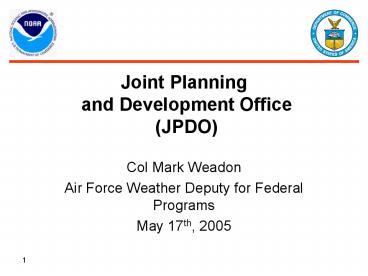Joint Planning and Development Office (JPDO) PowerPoint PPT Presentation
1 / 13
Title: Joint Planning and Development Office (JPDO)
1
Joint Planning and Development Office (JPDO)
- Col Mark Weadon
- Air Force Weather Deputy for Federal Programs
- May 17th, 2005
1
2
Outline
- Purpose
- Issue
- Background Discussion
3
Purpose
- Information Briefing
- History
- Current activities
- Schedule of events
4
History
- 2002 Commission on the Future of the United
States Aerospace Industry - The Administration should immediately create
a multi-agency task forceto develop an
integrated plan to transform our air
transportation system.The Joint Program
Officebrings together needed participation from
FAA, NASA, DoD, DHS, NOAA, and other government
organizations. Within a year, the Joint Program
Office should present a plan to the
Administration and the Congress outlining the
overall strategy, schedule, and resources needed
to develop and deploy the nations next
generation air transportation system - January 2003 DOT Secretary Mineta/FAA
Administrator Blakey formed Joint Planning Office
5
Public Law 108-176 December 12, 2003FAA
ReauthorizationVision 100
- Establishes the Joint Planning and Development
Office (JPDO) - Establishes a multi- agency Senior Policy
Committee - Requires the JPDO to
- Operate in conjunction with relevant programs in
specified government agencies - Consult with the public and ensure the
participation of experts from a broad range of
entities within the private sector - Establishes the requirement for an integrated
national plan - Plan must meet air transportation safety,
security, efficiency and capacity needs beyond
those currently included in the Operational
Evolution Plan (FAA 10-year outlook)
6
Integrated Plan Requirements
- National vision statement for an air
transportation system that will meet the
potential demand by 2025 - Description of the demand and future system
performance characteristics including goals,
objectives and policies and underlying
assumptions and analyses - Multiagency RD roadmap
- Description of operational concepts to meet
projected system performance requirements with
timelines and budget requirements to meet 2025
vision - Note Plan delivered to Congress December 12th,
2004
7
Governance and Execution
- Senior Policy Committee (SPC)
- Chaired by Secretary of Transportation Mineta
- Secretary-level group in some cases (DOD)
participation is delegated) - Three SPC meetings held since October 2003
- Joint Planning and Development office (JPDO)
- Integrated Product Teams (IPTs)
8
Key Issues
- JPDO Goals
- Program scope is curb-to-curb
- Triple 2001 capacity
- 30 reduction in consumer time
- 25 reduction in consumer cost
- Budget
- Department budgetary authority not transferred
- Direct OMB interaction
- Level of programmatic authority still under review
9
Integrated Product Teams
- Harmonize Equipage and Operations Globally - FAA
- Develop Airport Infrastructure to Meet Future
Demand - FAA - Integrate Air Transportation Security Activities
- DHS - Establish an Agile Air Traffic System - NASA
- Establish User-Specific Situational Awareness -
DOD - Establish a Comprehensive Proactive Safety
Management Approach - FAA - Environmental Protection that Allows Sustained
Aviation Growth - FAA - Develop a System-Wide Capability to Reduce
Weather Impacts DOC/NOAA
10
Weather IPT
- IPT formed September 2003
- NOAA/FAA/NASA/DoD/Academia/NCAR participation
- Limited industry participation to date
- Six Weather IPT sub-elements
- Observations (ground, aircraft, and space-based)
- Forecasts (includes wake vortex)
- Dissemination (weather information network)
- Integration (probabilistic decision tools)
- Training (Meteorologist/pilot/controller/dispatch)
- Mitigation (aircraft equipage)
- Policy/Outreach under consideration
11
Weather IPTConnections to other IPTs
- 4-D weather information pushed through a System
Wide Information Management (SWIM) architecture - Common weather operational picture
- Cockpit/Virtual Tower/Dispatch
- Enroute Air Traffic Management
- Capacity/Efficiency enhancement
- Supporting 10000 Unmanned Aerial Vehicle Fleet
- Airport Operations
- Ground operations
- Capacity/Efficiency
- Safety
- Security
- Environmental (e.g., sound/pollution)
- Weather related sensor development
- Wake Vortex
- Next generation approach
- International leadership
12
Weather IPTNext Steps
- Department budget guidance for respective FY07
budget formulation processes will be submitted
from JPDO to Department OMB examiners - Action plan development underway
- Outcomes/Alternatives to be identified
13
Weather IPTNext Steps
- 2005 System Requirements (National Operational
Requirements Document) - 2005-2007 Aviation Weather Policy Reviews
- 2010 2012 First Phase Weather Information
Network - 2015 Second Phase (Probabilistic information)
- Ongoing Decision support tool development and
integration into national airspace system
operational platforms

